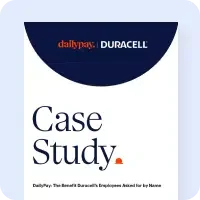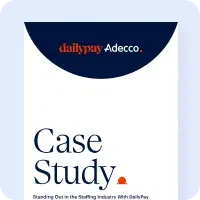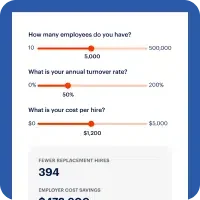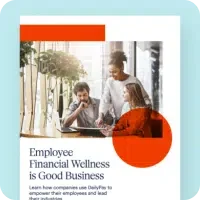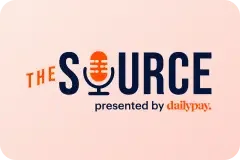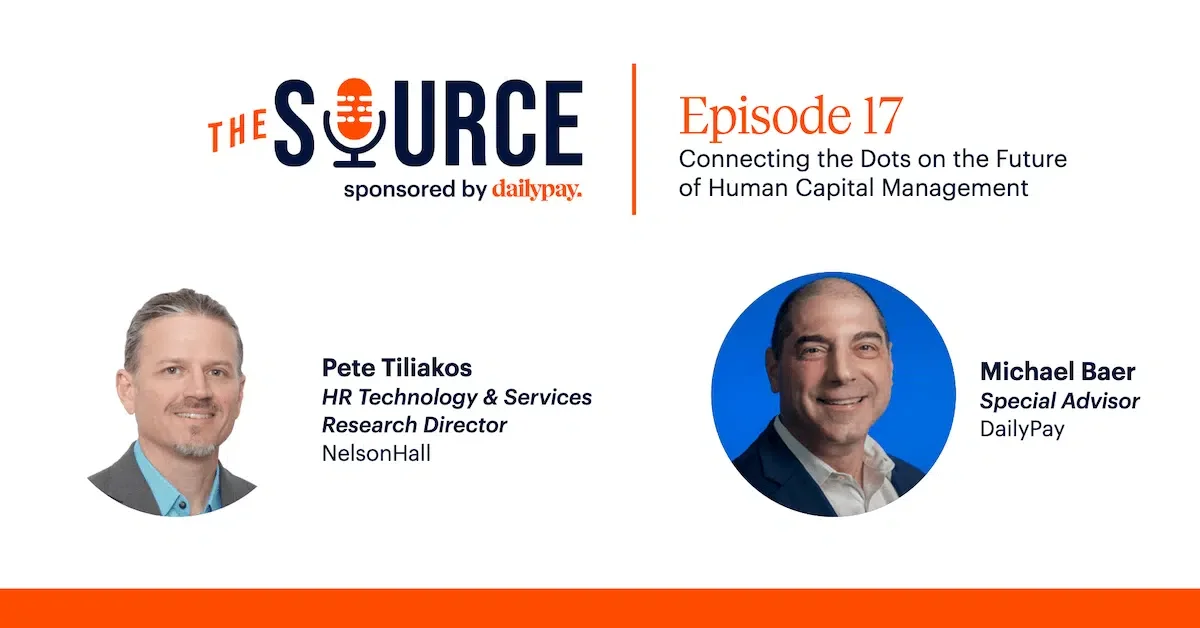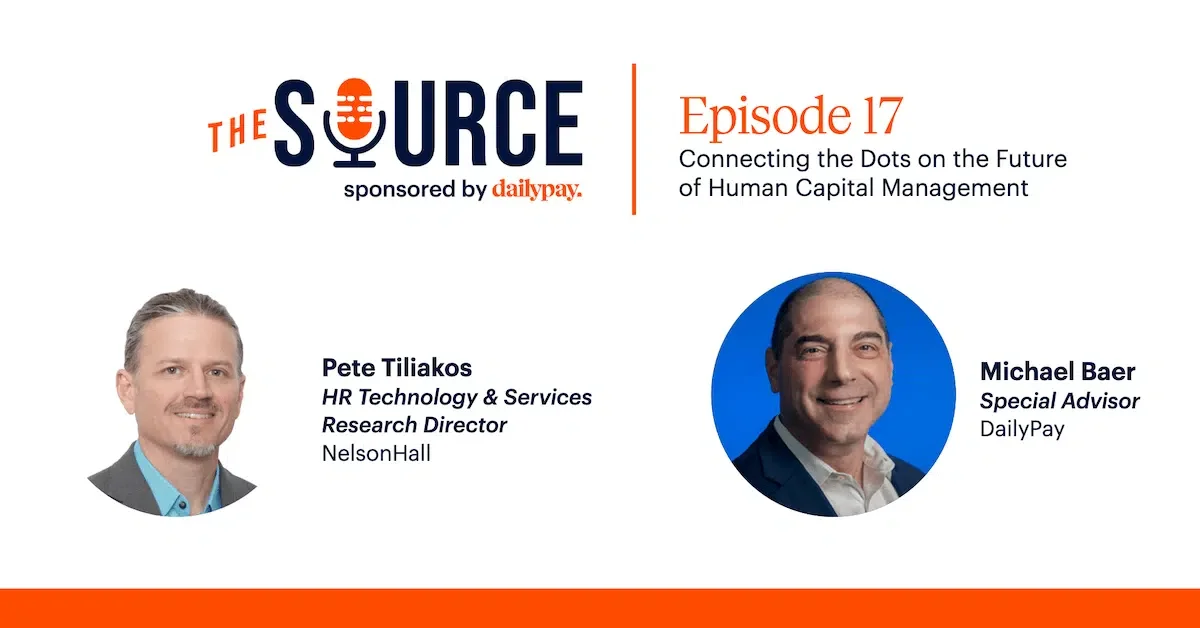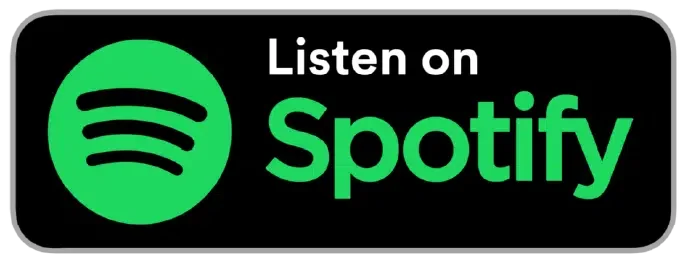If managing employee data has become more of a science, then NelsonHall’s Pete Tiliakos is a scientist who specializes in analyzing the growing number of technological resources available for all facets of payroll and human capital management. His role is to help us understand the impact that new and different tools and resources have on successful employee management experiences. On The Source by DailyPay, Pete discusses how we got to where we are now in terms of systems and their usefulness, and talks a lot about the near future of employee data. management.
About Our Speakers
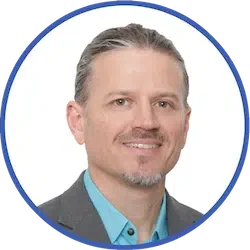
Pete Tiliakos is part of NelsonHall’s analyst team, which provides the most comprehensive and insightful coverage of HR outsourcing markets in the world. At NelsonHall, Pete has shared responsibility for HR services and technology research globally and leads research in the areas of Payroll Services, Global Employer of Record Services, and HCM Technology. With more than 25 years of experience in HR outsourcing, offshoring, and shared services, his deep expertise spans the sourcing lifecycle and has assisted numerous organizations, of all sizes with HR transformation initiatives.

Michael Baer is the host and executive producer of The Source podcast. Michael previously oversaw domestic and international payroll news and analysis at Bloomberg Tax, previously BNA.
In a career spanning three decades, Michael transformed the role of managing editor, becoming an information services leader who managed every aspect of world-class global products and platforms, while continuously increasing revenue and achieving market-best customer satisfaction. He directed a team of editors and writers who were charged with translating complicated tax and labor laws into English so non-lawyers could easily understand and apply them, and was integral in organizing and placing that content on easy-to-access web platforms, resulting in the highest net promoter scores the company had seen for any of their offerings.
Michael has been a frequent public speaker for conferences and webinars, and now is the host of The Source, sponsored by DailyPay. Michael joined the DailyPay team in 2019.
In this podcast you will learn about…
- How consumer digital transformation has led to employee empowerment
- That digital payment adoptions are at different levels across the globe
- How more strategic HR and payroll roles will propel the future in employee data management
Welcome to The Source, the definitive destination for timely and informative regulatory updates and issues in the on-demand pay industry.
The Source is brought to you by DailyPay, the industry leading technology platform that’s creating the world’s next financial system by rewriting the invisible rules of money.
This material is for general information only and the views expressed herein reflect only the views of the participants. This program should be considered marketing material and should not be relied on as legal, tax, accounting or regulatory advice.
And now, let’s welcome the host of The Source, Michael Baer.
Michael Baer:
Hello everyone and welcome to The Source. The Source is sponsored by DailyPay and it provides insights into active and upcoming legislation and issues impacting the on-demand pay industry, HR, payroll and financial technology. And with special guests, we help clarify issues surrounding access to pay and the pay experience. And today we are grateful to have Pete Tiliakos to talk with us about connecting the dots on the future of human capital management or HCM. Pete serves as HR technology and services research director at the international consulting firm NelsonHall. With more than 25 years of experience in HR outsourcing and shared services, he has helped numerous organizations of all sizes with HR transformation initiatives and he leads NelsonHall’s research studies on HCM technology and managed payroll services. Welcome Pete.
Pete Tiliakos:
Yeah, great. Good to be here.
Michael Baer:
Wonderful. Well, first I’m curious, what got you into this line of work?
Pete Tiliakos:
Yeah. No. Yeah, great question. It’s funny because I think we even talked about this a little bit, I don’t know if anyone sort of starts off their career when they’re younger saying, “Hey, I want to end up in payroll or HR,” but we do sometimes and it’s been a great experience for me. I actually started my career oddly enough, in the US Marine Corps and went in with really no expectations for what that was going to be like. Actually the first Gulf War was ending so I didn’t really know. And I ended up working in what ended up being the first, what I understand is the first shared service center that the Marine Corps put together where they consolidated really back office processes into a single center. And we operated it for the entire base of Paris Island.
Pete Tiliakos:
I literally launched my career in the military doing pay and entitlement audits. Basically core HR data and payroll data. And then later, left that world after about four years and ended up working for one of the largest at the time, the largest PEO providers serving small businesses in the US. That business ultimately became what is TriNet now. And then after that, I had the really crazy fortune of being able to help the Walt Disney Company establish their shared service center and I managed payroll for them for a number of their entities and really got an incredible amount of experience at a very, very diverse organization, managing payroll and converting systems. We were doing system upgrade back then to what was SAP’s latest version globally. And from there ended up going back into HR outsourcing and I worked for a number of the providers in the space that you might be familiar with and then ultimately ended up consulting around that capability of for Deloitte.
Pete Tiliakos:
And then after about three or so years, I ended up here at NelsonHall and I’m really fortunate. As an analyst, I never saw myself doing this but fundamentally it really has been a privilege. Just being behind the scenes and under the hood, if you will, of all the latest HR tech and HR technology and services offerings out there is really exciting. And I just love watching it, tracking it, learning about it and fundamentally helping buyers really understand how to think about it and navigate it. Long story, long path, but just sort of by happenstance, I guess you could say ended up in his space, like a lot of folks.
Michael Baer:
Well, thanks for that. And I think you’re right at least when I came up in the business myself, I can’t say it’s something that I aspired to do but I found that there is great opportunity in the space and a lot of fulfillment. And it sounds like you’ve had such a broad breadth of experiences and you’re able to apply them now in your role at NelsonHall and that’s great.
Pete Tiliakos:
Yeah, thank you.
Michael Baer:
In the evolution of HCM and payroll solutions, what do you think are two or three most significant developments that you have seen that have proven to make a huge, positive difference for employers and employees when it comes to systems?
Pete Tiliakos:
Yeah. No, that’s a great question. I think it’s pretty straightforward, really. Modernization and consumerization of HR technology or just technology in general has really been the key there. For a long time, it’s sort of cliche to say this, but it was sort of the Jetsons in your pocket and at home, but at work, you were kind of dealing with this sort of Flintstones sort of experience. You can buy a flight, you can buy shoes, you can do just about anything, you could find a date on your mobile phone or on demand if you will, but you couldn’t look at your payslip or you couldn’t enter your time in that way. All of that is sort of coming around to the fact that we need to modernize and that’s really been driven by things like cloud platforms. Certainly mobile technology is absolutely taken off in recent years and past years and really dynamic integrations. The extensibility of all of these platforms connecting together and being able to provide a flow of information and data back and forth has been phenomenal. It had a phenomenal impact.
Pete Tiliakos:
I was just talking to this the other day with some of my friends that are small business owners and I was just explaining to them that I think the reality of it is, and this has been for some time now that every company really, regardless of what they do or offer, they almost have to be a technology company today. They really have to remain competitive and to do that, or even just relevant, if you will, they’ve got to provide a modern technology driven client experience. And that certainly has spilled over into the employee space as well into the workplace and employees want that same capability and experience as well. And so fundamentally, I think you have to look at your employees somewhat as customers in some ways to the business. And they expect an equally great experience that provides them the ability to be successful in their roles and fundamentally achieve their own personal goals.
Pete Tiliakos:
And all that is really empowering employees that just take more control of their data, give them more control of their careers and really help them shape their own work experiences to their personal desire. And in turn, offloading a ton of work for payroll and HR. For so long, those groups have suffered with a very manual process and very limited investment. And now you’re bringing in these new abilities to automate and augment and really remove all of that manual work to allow them to focus on more appropriate tasks. More value added tasks and enabled them to bring more strategic value back to their business while they support the workforce more effectively. I think it’s just a fundamental consumerization, if you will, of technology that has really spilled into the workplace and fundamentally is catching up to where our personal lives have been and really giving employees a tremendous amount of opportunity to take control, but also giving HR a tremendous amount of relief and help.
Michael Baer:
Well, very significant. And if you will, I’ve got an additional question to add on to that one. And that is, it seems to me that the systems that have been put in place in the past decades have been for HR and payroll were kind of more geared to efficiency and they still are without a doubt. But now there seems to be this recognition that these systems have to be kind of employee pliable as well. Am I right on that?
Pete Tiliakos:
100%. I think what it is, you have to imagine, we say this a lot as analysts, but look, you can have the best piece of technology in the world, but if no one will engage with it and use it, it’s sort of pointless. It’s not going to provide the data that you need. It’s not going to provide the impact. Absolutely. The past of creating systems around a process only and creating it purely for the business, a very kind of almost tactical feel was the way things were designed in the past. Whereas now it is much more about the user. Beyond the workplace you hear, I think you hear the word personalization and customization more so than ever in every product that’s out there. And that is really come into the workplace in a tremendous way. And I think employees are being able to really be empowered now. But you’re right, it is fundamentally about the end user. It is absolutely about the end user now. And that sort of legacy way of looking at systems is really going away.
Michael Baer:
Yeah. It seems like there have been a little flip there. Coming out of this pandemic, what are some of the biggest challenges you see facing employers as they are struggling to get a handle on effectively managing employee data, monitoring work coming out of this?
Pete Tiliakos:
Yeah, yeah, no, there was a lot and I think a lot of firms really had an opportunity to kind of put their solutions to the test and find out if their operating models were ready and many found that was not the case, they needed some to do some work. I think first and foremost, what is the big challenge is business continuity and just maintaining resilience in volatile times. Being able to pivot and respond in a crisis. COVID is not the last challenge that we’re going to face and it’s not enough to hope that you can kind of weather those. Transformation I think for a lot of companies was overdue and the pandemic certainly exposed gaps and pretty quickly woke a lot up to the reality that their operating models just weren’t ready for that level of volatility. I think resiliency and business continuity is one key challenge.
Pete Tiliakos:
I think the other challenge that we saw too was just the access to reliable data for decision making. That is so critical. HR and payroll are sitting on some tremendously rich data that often just goes under utilized. I say that a lot about payroll but I think there’s a lot of data that is there that is not understood. The tools aren’t there to help HR be able to understand it. And those that had a more modern, tightly integrated, global HCM sort of landscape fared much, much better in accessing good quality data and really made better decisions likely quicker, faster than their peers. Now you’ve got, I think the other thing too, that that has become or was a real challenge was work from home and now what’s becoming work from anywhere, supporting and developing a diverse globally dispersed workforce. It requires staying connected and staying engaged.
Pete Tiliakos:
And particularly as the work is now shifting to more gigs and projects and team run, you’re sourcing talent from all over the globe. Bringing them together and supporting their productivity, that requires technology and tools and a user experience that warrants, like we just talked of them gauging the system. Because without their interaction to the system, none of this is going to be possible and the data’s not going to be there. The other thing too with that, if you’re dispersing employees around the globe, money movement is an issue. We saw that as a big challenge, particularly during COVID. Digital technologies helped a bit there and moving money around has never been so important. Getting funds to people. More digital adoption and capability would have likely helped made that even lesser of an issue for some.
Pete Tiliakos:
But then I think also the other thing that was an issue prior to COVID, it’s an issue during COVID and it’s going to stay an issue is really finding, developing and retaining top talent in what is really a brutal marketplace. The war for talent is absolutely real. And the employee experience is really the new business case for HR to transform. And having that robust experience can be the difference between a talent or a candidate saying, “I want to work for you and I want to work for your competitor.” All of those things I think have really just bubbled up and become highlighted during this time. And I think that’s what you’re seeing, why you’re seeing the acceleration of adoption for digital solutions now so much more than maybe we were.
Michael Baer:
Yeah. And those digital solutions again, the theme is very clear here that they have to include an ability of employment employees to engage in those systems and actually have some fulfillment from using them. Not just to enter their time or something like that.
Pete Tiliakos:
Yeah, totally.
Michael Baer:
There needs to be a lot more to the engagement than what is your basic function? Moving on here, you consult across the globe, many organizations across the globe and your company’s based in the UK. There are a lot of differences in how systems are set up to meet requirements for each country. And the US, for example, has a very unique setup as well. However, there are universal things that work all over and it seems that some applications that may be adaptable for work all over the globe, sometimes they just, they start someplace and then they kind of migrate to others. They’re inconsistently offered and adopted in some areas, whereas they’re fully integrated and accepted in others. What are some of the technologies may that maybe you see US employers are leading in the adoption of? And what technologies are US employers maybe lagging in? Or we can expect maybe to put into place here in the US compared to their peers and other regions?
Pete Tiliakos:
Yeah, that’s a great point. I think now we see a lot more of firms starting to support global footprints. They’re creeping out, you’re right. Whether that’s mergers and acquisitions, whether that’s work from anywhere, whether that’s just the fundamental need to expand their business footprint, we’re seeing a lot more of that. And the reality of it is, and this is very, very true for payroll, but certainly holds true for every tower of HR is that localizations from country to country are complex. They vary. What works in one country is not necessarily designed to work perfectly in another country. There has to be a localization level to that. That’s very, very important right now. But I think the employee experience is certainly front of mind, regardless of what geography someone is operating in. All employers are seeking to boost their employee engagement, better care for their employees through wellness and fundamentally give them that experience that we talked about to really attract and retain the best talent possible.
Pete Tiliakos:
And certainly they’re looking for an edge over their competing employers and looking to retain their top candidates or tap into those top candidates. And they’ve got to differentiate that experience and that requires modern technology and tools to support the day to day but also support them in their journey. As you pointed out, it is more than tech. It’s more than just getting a transaction done. It’s about helping them meet their career aspirations also. And certainly, as I mentioned, as we just said, the employee experience is more than that. It’s also giving them meaningful work. It’s absolute inclusion. It’s prioritizing their wellness, physically, mentally, financially. And I think US employers have historically been out in front when it comes to maybe investing in and adopting more digital HCM solutions. Cloud HR is a great example of that. I think we’re certainly seeing the US lead in cloud HR adoption.
Pete Tiliakos:
And another great example is DailyPay’s product, the on-demand pay world. Some of the key challenges we see in the US, the un-banked millennials, wage disparities or gaps, workers living paycheck to paycheck. All those trends are giving way to modern, digital solutions like on-demand pay. And that’s certainly helping support that improved financial wellness for employees and one of the things I love about that is just the impact of adopting those things has been tremendous to both the employee but also the employer and very simple to deploy. And it really gives the employee the control and the empowerment that we’re talking about. We’ve been saying in this theme.
Pete Tiliakos:
I think for on-demand pay specifically as an example, the adoption has been a little slower outside the US for various cocktail of reasons, whether that’s the social support for workers is different. The livable wages are more common. You have different cultural concerns. I know GDPR has been sort of a concern and just fundamentally Peter, there’s economic differences but we still see that adoption accelerating globally as well. Geographies like say in AsiaPac have been quite strong and really almost leading others in terms of say digital payment adoption, things like Venmo or GCash or even a cryptocurrency payment option, we’ve seen a bit more of that from the AsiaPac region than I’ve seen from others but I think the pandemic helped to accelerate that globally. I think other firms are now looking outside of their traditional direct deposit and checks to say, “What else can we offer?” Whether that’s pay cards or other methods but I think on-demand pay is a great example. It’s a digital solution that does more than support employee wellness.
Pete Tiliakos:
And when you combine that with continuous payroll calculations that we’re seeing come online, I think it’s really going to help break down things like shortening cycles and really helping workers again, take more control and shift to more of a digital process versus a legacy solution. And ultimately all those things are great. More personalization, more empowerment, and certainly a viable way of moving money digitally that’s universally impactful for employees. I do see that picking up outside the US. I would say, I don’t know if I have any examples of laggards for the US. I think the U S has done a pretty good job of being a little bit more forward and adopting these things. But I think that’s a great example though, that product of how it has been slower in other places but I think you are going to see it begin to ramp up and take off and maybe for different reasons but certainly a capability that’s here to stay, I believe.
Michael Baer:
Yeah. We certainly can understand that many of the countries, the organizations that pay people across the globe in other countries, there’s a monthly payroll, primarily. And people really have to stretch to make it from a paycheck to paycheck there. I would think that it is ripe for this kind of a solution.
Pete Tiliakos:
It really is because when you think about again, we’re getting real time calculations in payroll, we’re getting more digital. We’re seeing money movement now. A lot more the rails are coming online where you can see same day deposits, next day deposits. There really is no reason for these cycle times to be so long. We’re seeing the cycle time for payroll shrink and shrink and more and more as you bring on things like on-demand pay, I think it’s just making it, you’re right, a more rapid way of getting employees paid timely and accurately and just giving them more control over what they’re doing. But I really do think digital things like this will break down the traditional ways of thinking and doing things in payroll and HR and shift us towards an opportunity to come up with new ways of thinking and doing things. I think it’s very, very exciting.
Michael Baer:
And I like how you expressed earlier on about how something that’s universal is that employee experience and that recognition that how critical that getting that piece right is becoming for successful organizations. I think that was one observation. And then a final observation I have is that we look at some countries, particularly, maybe in AMEA area, Africa, they completely digital transactions for their pay. They have kind of quasi kind of currency usage there. I’m not that familiar with it, but I do know that I think that this is an area that maybe might be coming to the US. I don’t know. Maybe you could comment on that.
Pete Tiliakos:
Yeah. I do. I think you could see more of that. I think we saw recently was PayPal took a stance on-demand pay or shuttling their pay in digital methods. More and more companies are looking at this, I think you’re right and saying, “Hey, how can we digitize? How can we modernize?” And I think it is going to be those more forward looking firms and more forward looking areas that are going to do that.
Pete Tiliakos:
I think we saw was a Honduras, I’m probably saying it wrong, either Honduras or El Salvador, one of the Central American countries recently said they’re shifting to more of a crypto type currency and they’re encouraging employers to pay that way. I think there’s just more options now and more technology coming into play. And those trends, they’re certainly starting to take off for different reasons in different places, but absolutely, I think you can see it becoming something it’s certainly already standard in most payroll solutions now. I expect next year, we’ll see it a 100% and I think you can see as it evolves, the tools that are coming into play around it are really adding a lot of real value for the users that are taking it up.
Michael Baer:
Super. And again seems to be all surrounding this employee experience and pay experience kind of a theme. I’d like you to take a look maybe more into the future here, say the next five years or so. And there is a set up here that can allow us to make some projections. Let us take the larger company that has traditionally been forward looking, let’s just say that they’ve invested, they’ve made that decision to adopt systems and new ways to manage the data from the employee experience perspective. How will that company’s HR and payroll operations be different five years from now, do you think?
Pete Tiliakos:
Yeah, well, I think you’ll see a greater depth of digitalization. I think more of the processes becoming more digital, more of the use cases around the employee experience and the employee journey are becoming much more augmented and AI driven so you got a much more of a guided, informed and empowered experience. I think you’re going to see much more of that. More of the systems helping users always get it right versus needing to be an expert to get it right. Putting them right to the source of what they need to take action most efficiently but also informing them as they go. I think you’re going to see more of the embedded insights, in the moment type capabilities. Those things are going to continue. I think you’re going to see a much heavier use of AI and ML in the future, certainly natural language processing as well.
Pete Tiliakos:
I think you’re going to see a highly augmented voice enabled environment. Think Siri, Alexa, more, hey Siri, I need to take a day off or Alexa, I want to whatever. That sort of thing, voice enabled virtual assistants and guided support. I think you’re kind of getting what we’re getting towards. I think long, longterm is going to be almost a zero UI. You’ll hear some vendors talking about that, where it really may not have to log on. You can just fundamentally talk to the voice assistant that is connected and log on to the solution and help get that work done. And I think that’s going to happen, not just in our work world, we already see a lot of that happening over in our personal world where we’re saying, “Hey Alexa, turn off the light,” or, “Turn on the camera or whatever at the front door,” those things are just becoming normal and that’s part of what we do.
Pete Tiliakos:
And I think you’re going to see that organization, if they’re on that path of adopting modern solutions, those modern solutions today are being built, purpose built for augmenting users and bubbling up analytic insights and driving an augmented guided experience. You’re going to see more and more of that. Certainly, I think you’re going to see the practitioner role change, fundamentally taking away all of this manual work and offloading empowering employees to manage their data. That’s giving payroll and HR more time to focus on the real work that they probably should have always been able to do. Just fundamentally supporting the business, being that guided expert or strategic advisor to the business to give them the guidance as they navigate their strategic plan. I think it’s all about really just continuing on that digital path and bringing more and more tools and they’re just going to support the employee from every angle and really drive that experience that we’re talking about.
Michael Baer:
And I got to say, you kind of hit on something that struck me and that is, we want to reduce the number of clicks. We don’t want to make it difficult for people to get where they need to go digitally. But with that equation, and I see this, it’s got to develop hand in hand is the authentication process, this data security process. I’d like to ask if I could add on a question here is this company five years from now, what are the kind of processes that are going to ensure the data privacy and the security that is necessary and yet still have the convenience that we desire?
Pete Tiliakos:
Yeah, that’s a great question. I’ll be the first to admit I’m certainly not an expert probably in that realm, but I think from an HR perspective, obviously protecting employee data is absolutely critical. I know that GDPR and things like that have come online to really help employers obviously guide them in the right direction for how they should be treating data. We certainly see a number of compliance initiatives around certifications that can be done to make sure that vendors that you’re working with are in fact applying the highest level of encryption and security to their data. That’s going to be a real challenge. As we’re putting more voice enablement, more mobile you’re absolutely right. Data security is absolutely front of mind and I think it’s really going to be those controls and those technology advancements around security that are going to help with that.
Pete Tiliakos:
And I think it’s important when firms are out there buying these solutions and engaging service providers, that they are looking at that compliance and security levels that their vendors are providing them to make sure that they are checking the box on those must have sort of table stakes controls and capabilities in house to make sure that data is secure. But you’re absolutely right, I think that’s a challenge for everything. In our personal lives and our professional lives. That’s a big, big challenge that I think is going to have to, and who knows may create new stuff that will come about. Blockchain is really doing a lot for credentialing people and validating people’s credentials from fraud and things like that. I think more of those sorts of technologies, there may be something out there that’s not there yet but I think those are the types of things that’ll help with that.
Michael Baer:
Okay. Well, thanks for filling us in on that part. Along the lines of the future, there are a lot of players out there providing services for HR and payroll. And some claiming the complete turn key solution, others in various aspects of employee and pay experience that are experts in a particular aspect of that employee and pay experience, like we are on the payment side of the payroll equation. Do you see HCM and payroll system applications actually kind of becoming more consolidated into a say an attempt for a complete solution to all aspects of HCM, payroll? Or will there be a push to have more alternatives that are compatible with the big systems? Like you can add an auxiliary, like a phono, a different turntable for your old stereo system. I’m dating myself now, because it’s a better turntable, that kind of thing. I know this is kind of a curve ball, but what do you see here in terms of this complete solution and then also having this industry have these kinds of plug and play solutions?
Pete Tiliakos:
Yeah. No, that’s a fantastic question. And look, I think it’s important to point out that every company is different and there’s not a one size fits all answer. As analysts, we get asked all the time, “What is the best fill in the blank?” Payroll, HR, whatever. And I always say, “Well, if you get an answer to that, it’s probably wrong.” Because the reality of it is, is everyone’s different. Everyone’s on a different journey. It’ll start and even end that journey in the same place or move at the same pace. Hopefully it’s always linear but sometimes it takes a while to transform and change. And so, it’s just not a one size fits all. But generally to your point, what we do see is, downmarket your smaller firms, you see a lot more all in one platform being acceptable in meeting their needs.
Pete Tiliakos:
They can typically fit into a solution out the box and it’s good for them as they grow. But once you start to move up market, as firms expand or they make acquisitions or they move towards different types of operating models, the ability to plug and play, if you will, to integrate, we talk about dynamic integrations, APIs, that is really critical. Because I might have something in my organization that is unique, that is that 1% thing that my system doesn’t offer. And I may need to connect that and purchase that from a solution provider, a niche provider that actually has that capability. And that really adds a lot of value to address their unique needs and seamlessly provide that capability to their end users. The integrations make it feel as though it’s embedded in your system. It’s intended if you will and it provides a very seamless experience.
Pete Tiliakos:
Let’s talk about, for example, DailyPay, your on-demand pay solution for early wage access, is a great example of an integrated solution that helps to address a very unique wellness challenge for the adopting firms. I think tapping into those solutions comes by way of those advanced integrations. And that is really the pipeline and or the artery, if you will, for the data movement and the flow that gives that deep seamless integration and feels to the employee as if they are operating inside of one solution. For global payroll, integrations are absolutely crucial to move the data back and forth to the calculation engines. As we know, there’s not one solution out in the market that will support a 197 countries natively. They either are or have a certain native capability to an extent and then connect partners where they need to do that, partner engines.
Pete Tiliakos:
If you don’t have that tightly integrated, the data flow is not going to be seamless if at all and you’re kind of left with this manual mess of trying to sort of move and co-mingle data manually, which is just not optimal. What we are seeing though, I would say is just holistically market-wide is really the demand too, for the microservices architecture, where firms can easily make small configurations or mini apps, if you will, to support their unique needs and fill white spaces. In other words, providers are building their platforms in a way that they can be highly extensible and connected to other things, creating an ecosystem to help a buyer organize and create that environment that is ideal for them.
Pete Tiliakos:
You talked about the plug and play with the phonograph. I like to think of it as and you’ll probably relate to this, every time I used to do a global payroll solutioning with a customer when I was on a pre-sales capacity, we would work on these global deals and every time we would work with this really big company and we would find out about these couple of little access databases that were keeping payroll kind of going. It wasn’t calculating anything, but at the end of the day, it was providing some thing that the payroll or the HR system couldn’t provide, whether was tips or some sort of commission or something maybe for a specific work group. And it was always one guy, Ted let’s say, down in the basement who had been working for the company forever, that maintained those databases. And without Ted, payroll couldn’t run every week.
Pete Tiliakos:
That doesn’t need to be happening. That doesn’t really need to be necessary anymore. Now you can find those solutions, if you will, in the marketplace through integration you can connect that, solve that issue and have a very good experience, a very reliable experience and you don’t have to worry if Ted is going to retire or make it to work this week so that payroll can run. That I think is a good example of where firms are unique as I said, in the beginning and they need to be able to address those unique challenges and sometimes the HCM or the payroll or whatever they’re using might not hit every single thing. And that’s okay. There are vendors out there every day popping up with niche capabilities that are really fascinating and innovative and being able to tap into those through that integration is really, really valuable.
Pete Tiliakos:
I think fundamentally, providing that ecosystem to support the business and integrate the things that they need for that deep personalization, if you will, or customization, that’s kind of the bad word in the software world to support their needs is really what is really great because HR and the business often have unique challenges that just are out of the box and they need help with it. And that extensibility, it really gives them a lot of options to plug and play those things.
Michael Baer:
Well, that’s great. I thought I was going to have a follow up question but I think you’re pretty complete in your response there, Pete. When you mentioned Ted, it really got to me as well, because I think folks in payroll know about Ted who developed the system that is still running now, but put together with bubblegum and duct tape at this stage.
Pete Tiliakos:
It’s scary.
Michael Baer:
It’s scary. It’s scary. Primarily I hear that from the data security because it’s just such a challenge there. But anyway, well, this is wonderful. Thank you so much, Pete, for helping us connect the dots today on this, look into the future of HCM and payroll services. And you can bet Pete is staying engaged. He’s got his finger on the pulse of global HR and payroll service development so we will hear more from him at upcoming events.
Pete Tiliakos:
Yeah, absolutely. Thank you so much for having me. I’ve got a lot of content and events coming up over the summer and this fall and you can keep up to date or keep posted if you will, on all of these topics by following me on Twitter @PeteT_NH.
Michael Baer:
Wonderful. That’s PeteT_NH, listeners. And listeners, I want to thank you for joining us today at The Source by DailyPay. Just go to dailypay.com, Look for the podcast page. And we are also available on Apple, Spotify and Google podcast platforms. Stay healthy and safe. Keep an eye on your emails and social media as we will have another compelling issue along with updates very soon. Thank you very much. Have a great day.
Speaker 1:
Thank you for attending The Source brought to you by DailyPay, the industry leading technology platform who’s re-imagining the way money moves. Join us again next month for up to date insight on the on-demand pay industry. Keep an eye on your inbox for more information regarding featured guests and new topics.

